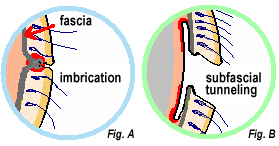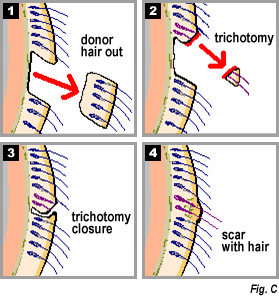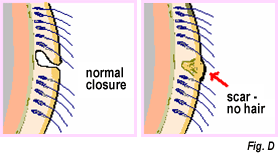All skin incisions produce scars, including those made by the best surgeons. Traditional hair transplant donor scars have a width of 1-3mm in 95% of patients and 2-3% of patients may see their scars even wider. The key to minimizing scar visibility is to directly address the factors contributing to a widened scar, like the healing characteristics of head tissues and collagen. Fortunately, the New Hair Institute (NHI) uses many surgical techniques to minimize scarring and scar widening.

Fascial Closure Technique: A fascial closure can be utilized to reduce wound tension when two skin edges are brought together, therefore reducing the likelihood of scar stretching. Before exterior sutures or staples are placed, we imbricate (or overlap) the underlying fascia, which is the fibrous tissue network located between the skin and the underlying structure of muscle and bone beneath the skin. (Fig. A) A more complex fascial closure is made when tunnels are created below the fascia to further reduce tension upon closure. (Fig. B) The final sutures or staples on the skin are not shown in the diagrams.

Trichophytic Closure Technique: A trichophytic closure, “hair loving” in Latin, promotes hair growth directly through a healing wound. For many years plastic surgeons have used this technique while repairing hairlines during brow lifts or in conjunction with face lifts. A small piece of one wound edge, as well as the corresponding hair, is removed. When the wound heals and a scar is formed, the buried and partially cut hair follicles will begin to grow through the scar. (Fig. C) Since hair follicles cut in this manner resume growth, there is no unnecessary follicle waste. When scars are wider than the 2 to 3mm range, this closure technique is less effective, because it typically promotes hair follicle growth only within a 2 to 3mm width where the trichotomy was done.

However, both of these techniques do not account for patient variability. The physiology of wound healing and scar formation is a very complex matter with numerous books devoted to the topic. Some patients heal with a virtually undetectable scar, less than 1mm, without any special closures while others form a wider scar despite fascial and trichophytic closures. Scars within the 2-3mm range are widely accepted since surrounding hair growth usually disguises any scar formation and few of my patients ever complain of a 2-3mm scar (Fig. D) that they can not see.
Update: Please see Trichophytic Closure Photos
Illustrations by Jae P. Pak, M.D.






